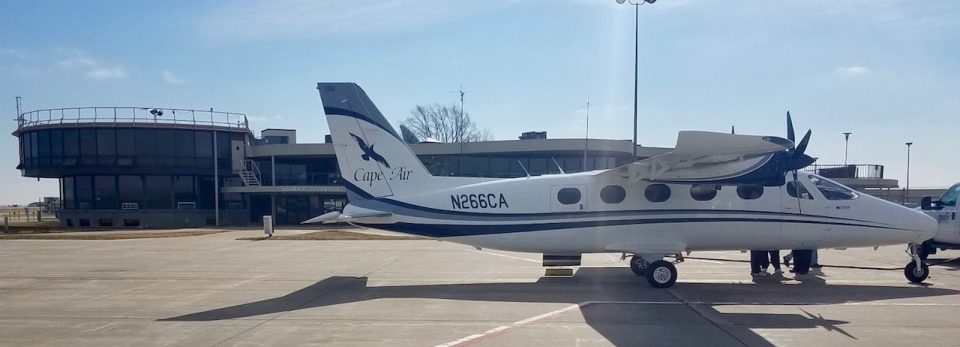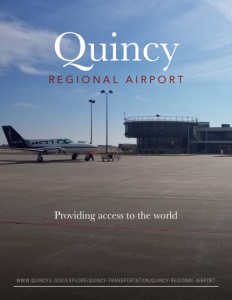Quincy Regional Airport
Providing access to the world
Business View Magazine interviews Sandra Shore, Airport Director at the Quincy Regional Airport, as part of our series on regional American airports.
Quincy Regional Airport, also known as Baldwin Field, is a commercial and general aviation airport located 12 miles east of Quincy, a city in Adams County, Illinois. The Airport was named after Thomas S. Baldwin, an inventor and aviator who was known as the “Father of the American Dirigible.” As a young man, Baldwin was a circus performer who, in 1887, made the first descent by an American from a hot air balloon by parachute, and thereafter toured the country with his feats of aerial daring-do.
In 1904, Baldwin built an aerodynamic, cigar-shaped, hydrogen-filled dirigible called the California Arrow, using a seven-horse-power, Hercules motorcycle engine, and received the Aero Club of America’s first balloon pilot certificate. Baldwin’s interest in the sky began turning to airplanes, and in 1909, he started working for the Curtis Project, building practical models. In 1910, he completed his first airplane, the “Red Devil,” and was issued Aviator License #7. On September 10th of that year, Baldwin made history with the first airplane flight over the Mississippi River.
In 1914, Baldwin returned to dirigible design and development, and built the U.S. Navy’s first successful dirigible. He served in the Army Aviation section of the Signal Corps, as a captain in 1917 and a major in 1918. After the end of World War I, he joined the Goodyear Tire and Rubber Company in Akron, Ohio, as a designer and manufacturer of their airships. Thomas J. Baldwin died on May 17, 1923, and was buried with full military honors at Arlington National Cemetery.
Today, the Quincy Regional Airport – Baldwin Field covers 1,101 acres and has three runways: 4/22 is 7,098 by 150 feet and made of asphalt/concrete; 18/36 is 5,877 by 150 feet, and is also asphalt/concrete; and 13/31 is 5,397 by 150 feet, and made of asphalt. It is owned by the City of Quincy, and operates with a staff of seven. “Our budget is made up of aeronautical and non-aeronautical revenues and then the city makes up the rest in the form of a general fund subsidy to help us get back in the black,” says Airport Director, Sandra Shore. “But I believe it is a smart investment because of the economic impact it has on the rest of the region.”
Over the years, the Quincy Airport has been served by various commercial carriers: Mid-Continent arrived in 1947; its successor, Braniff, left in 1959; TWA arrived in 1948 and left in 1953-54; and Ozark arrived in 1950 and left in 1982. Most recently, it was served by United Airlines partner, SkyWest Airlines, which was replaced, just this past January, by Cape Air which now offers daily round-trip flights to both Chicago O’Hare International Airport and St. Louis Lambert International Airport. “It’s the first time in the modern era that we’ve been able to connect passengers to two different hubs,” Shore notes.
Other Airport tenants include a collegiate flight program through Quincy University and Air USA, a major U.S. Department of Defense contractor. “They take outdated foreign fighter jets, fix them up and modernize their technology to help support and train United States airmen,” Shore says. “They were recently one of seven civilian contractors awarded a piece of $6.4 billion dollars in DoD contracts, and they’re a unique tenant here.”
The Airport is also home to some 50 general aviation aircraft, and according to Shore, there’s a waiting list for GA hangar space. “We are ready to build more,” she reports. “We’re just waiting to phase out some old hangars so that we can tear those down and replace them with more modern hangars.” Shore adds that the Airport would build those new T-hangars itself, perhaps in combination with some, as yet, undesignated grant money. The Airport also offers ground leases to prospective developers who, because an area of the Airport is in an Enterprise Zone, would be able to take advantage of certain financial benefits. “We do as much as we can to help provide some of the infrastructure and then we allow any developer who wants to come in to take advantage of the incentives available for development purposes,” Shore explains. “We also may offer a rent abatement that may compound with the tax incentive to provide for a minimal cost for any size business that might need a place to develop.”
“We do our best to be as economically-friendly as we can,” Shore adds, noting that with other commercial service airports just hours away by car, being competitive, wherever possible, is just good business sense. “So, we do our best to make it feasible for anyone to travel out of our Airport, whether it’s a passenger, by offering free parking and low fares, or a business organization, by offering those tax and rent incentives to develop here.”
As it true at any airport, at Quincy Regional, there are always construction and rehabilitation projects afoot. “If you’re not under construction, you’re not doing your job right in the airport industry,” Shore quips. “So, this last year, we just finished the reconstruction of our secondary runway 13/31. This year, we are looking at reconstructing our main runway 04/22, and correcting a line of sight issue it has. It’s going to be upwards of a $22-million project when all is said and done. So, we are in the design and study phase of that to determine what the most appropriate approach is to fix that issue. And then, we look to be constructing that over two seasons – 2021-22. So, it’s a pretty major project, but when it’s done, we should have two beautiful and newly-constructed runways. Then, we have our everyday things like improving the terminal and our landside access, and smaller infrastructure projects to support everyday use. Right now, we’re purchasing a brand new Aircraft Rescue Firefighting vehicle in order to maintain the highest level of firefighting services that we can provide and for the safety of all Airport users coming and going.”
Long-term projects include re-aligning a couple of taxiways, growing the Airport’s complement of snow removal equipment, and Shore says that she’d like to see a major rehab of the terminal building. “That will be more difficult to fund,” she admits. “So, we’ll spend the next couple of years trying to figure out how to do that.”
Shore believes that Quincy Regional Airport plays an important part in the local economy. “We provide our region, which otherwise wouldn’t have access to any other hub airport, with affordable air service to connect them to the national air service system,” she states. “Second, we are healthcare and manufacturing hub for our region and many of those companies, including some of our largest employers, are based out of Quincy, and their accessibility creates an economic impact second to none. Back in 2012, that was $14 million and I can only imagine what it is today; we’re going to have another study done to asses just what it is. But, I think our ability to provide air service in a region that would otherwise not be able to have access to the national air service transportation system, as well as providing accessibility to our major employers, shows that we support this region in more than one way. And whether you use the Airport every day or not, we’re making sure that we’re helping build our economy right here at Quincy Regional.”
AT A GLANCE
WHO: Quincy Regional Airport
WHAT: A commercial and general aviation airport
WHERE: Adams County, Illinois
WEBSITE: www.quincyil.gov/explore/quincy-transportation/quincy-regional-airport




